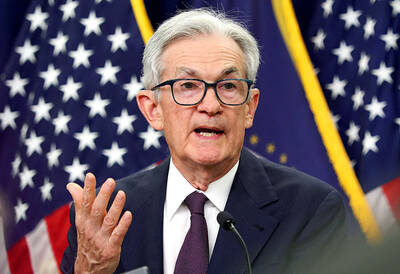Win Semiconductors Corp (穩懋半導體), the world’s largest pure-play gallium arsenide foundry, yesterday said that it is slowing capacity expansion this year as sluggish demand from Chinese smartphone chip designers is driving factory utilization to less than 70 percent this quarter.
The company plans to add 2,000 wafers per month to its plant in Taoyuan’s Gueishan District (龜山) by the end of this year, instead of 4,000 wafers as planned previously.
However, construction of a new factory in Kaohsiung’s Lujhu District (路竹) is to proceed as planned, as the new capacity aims to address longer-term demand in the next two to three years.

Photo: Screen grab from the Win Semiconductors Corp Web site
Besides, crucial semiconductor equipment delivery time has been stretched to between one year and one-and-a-half years since the outbreak of the COVID-19 pandemic, Win Semiconductors said.
“Chinese smartphone supply chains have entered an inventory correction period since the second half of the first quarter, which have had a severe impact” on suppliers, Win president Steven Chen (陳舜平) told investors on a conference call.
“As some of China’s major cities are under lockdown due to Beijing’s COVID-19 policy, it could continue to dampen consumer demand. Thus, we are conservative about how soon the inventory correction would be over. We do not have a clear picture about our customers’ situation,” Chen said.
“The correction is most marked among Chinese smartphone power amplifier chip designers,” he said.
Those customers account for 30 to 40 percent of the company’s smartphone power amplifier shipments, Chen said.
Reflecting dwindling demand, factory utilization is expected to slide further this quarter from 70 percent last quarter and 100 percent in the final quarter of last year, Win Semiconductors said.
Revenue this quarter is expected to dip to a high-single-digit percentage quarter-on-quarter from NT$6 billion in the first three months of this year due to weak cellular power amplifier demand, the company said.
Cellular power amplifiers accounted for about 50 percent of the company’s revenue last quarter.
Gross margin is forecast to drop to a multiyear low percentage in the high 20s or low 30s this quarter from 30.6 percent last quarter.
Despite the recent industrial turbulence, the company still holds an optimistic view about the mid to long-term business outlook, driven by 5G smartphones, 5G base stations, WiFi chips, 3D sensors and chips used in low-earth-orbit satellites, Chen said.
The company is maintaining its capital spending plan of NT$12 billion for this year, it said.
The firm’s first-quarter net profit declined 28 percent year-on-year to NT$786 million from NT$1.1 billion a year earlier.
On a quarterly basis, net profit plummeted 53 percent from NT$1.69 billion.
Earnings per share dipped to NT$2.08 last quarter, from NT$2.72 a year earlier and NT$4.19 in the previous quarter.
Gross margin tumbled to 30.6 percent last quarter from 33.5 percent a year earlier and 40.5 percent in the fourth quarter of last year, primarily due to lower factory utilization.

DIVIDED VIEWS: Although the Fed agreed on holding rates steady, some officials see no rate cuts for this year, while 10 policymakers foresee two or more cuts There are a lot of unknowns about the outlook for the economy and interest rates, but US Federal Reserve Chair Jerome Powell signaled at least one thing seems certain: Higher prices are coming. Fed policymakers voted unanimously to hold interest rates steady at a range of 4.25 percent to 4.50 percent for a fourth straight meeting on Wednesday, as they await clarity on whether tariffs would leave a one-time or more lasting mark on inflation. Powell said it is still unclear how much of the bill would fall on the shoulders of consumers, but he expects to learn more about tariffs

Meta Platforms Inc offered US$100 million bonuses to OpenAI employees in an unsuccessful bid to poach the ChatGPT maker’s talent and strengthen its own generative artificial intelligence (AI) teams, OpenAI CEO Sam Altman has said. Facebook’s parent company — a competitor of OpenAI — also offered “giant” annual salaries exceeding US$100 million to OpenAI staffers, Altman said in an interview on the Uncapped with Jack Altman podcast released on Tuesday. “It is crazy,” Sam Altman told his brother Jack in the interview. “I’m really happy that at least so far none of our best people have decided to take them

PLANS: MSI is also planning to upgrade its service center in the Netherlands Micro-Star International Co (MSI, 微星) yesterday said it plans to set up a server assembly line at its Poland service center this year at the earliest. The computer and peripherals manufacturer expects that the new server assembly line would shorten transportation times in shipments to European countries, a company spokesperson told the Taipei Times by telephone. MSI manufactures motherboards, graphics cards, notebook computers, servers, optical storage devices and communication devices. The company operates plants in Taiwan and China, and runs a global network of service centers. The company is also considering upgrading its service center in the Netherlands into a

NOT JUSTIFIED: The bank’s governor said there would only be a rate cut if inflation falls below 1.5% and economic conditions deteriorate, which have not been detected The central bank yesterday kept its key interest rates unchanged for a fifth consecutive quarter, aligning with market expectations, while slightly lowering its inflation outlook amid signs of cooling price pressures. The move came after the US Federal Reserve held rates steady overnight, despite pressure from US President Donald Trump to cut borrowing costs. Central bank board members unanimously voted to maintain the discount rate at 2 percent, the secured loan rate at 2.375 percent and the overnight lending rate at 4.25 percent. “We consider the policy decision appropriate, although it suggests tightening leaning after factoring in slackening inflation and stable GDP growth,”